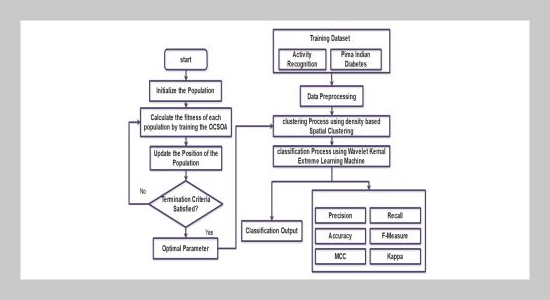REFERENCES
- [1] R. Selvi and I. Muthulakshmi, (2021) “Modelling the map reduce based optimal gradient boosted tree classification algorithm for diabetes mellitus diagnosis system" Journal of Ambient Intelligence and Humanized Computing 12(2): 1717–1730. DOI: 10.1007/s12652-020-02242-1.
- [2] K. M. Sagayam, D. J. Hemanth, X. A. Vasanth, L. E. Henesy, and C. C. Ho. “Optimization of a HMMBased Hand Gesture Recognition System Using a Hybrid Cuckoo Search Algorithm”. In: Hybrid Metaheuristics for Image Analysis. Springer, 2018, 87–114.
- [3] P. Koti, P. Dhavachelvan, T. Kalaipriyan, S. Arjunan, J. Uthayakumar, and P. Sujatha, (2020) “An efficient healthcare framework for kidney disease using hybrid harmony search algorithm" Electronic Government 16(1-2): 56–68. DOI: 10.1504/EG.2020.105236.
- [4] K. M. Sagayam, D. J. Hemanth, Y. N. Ramprasad, and R. Menon. “Optimization of hand motion recognition
system based on 2D HMM approach using ABC algorithm. In Hybrid Intelligent Techniques for pattern Analysis and Understanding (pp. 167-192)”. In: Hybrid Intelligent Techniques for pattern Analysis and Understanding. Chapman and Hall/CRC, 2017, 167–192.
- [5] B. Ristevski and M. Chen, (2018) “Big Data Analytics in Medicine and Healthcare" Journal of integrative bioinformatics 15(3): DOI: 10.1515/jib-2017-0030.
- [6] K. M. Sagayam, S. Suresh, D. J. Hemanth, L. Henessey, and C. C. Ho. “Optimization of SVMBased Hand Gesture Recognition System Using Particle Swarm Optimization and Plant Growth Simulation Algorithm. In The Biometric Computing (pp. 185-200)”. In: The Biometric Computing. Chapman and Hall/CRC, 2019, 185–200.
- [7] I. Dinov, B. Heavner, M. Tang, G. Glusman, K. Chard, M. Darcy, R. Madduri, J. Pa, C. Spino, C. Kesselman, I. Foster, E. Deutsch, N. Price, J. Van Horn, J. Ames, K. Clark, L. Hood, B. Hampstead,W. Dauer, and A. Toga, (2016) “Predictive big data analytics: A study of Parkinson’s disease using large, complex, heterogeneous, incongruent, multi-source and incomplete observations" PLoS ONE 11(8): DOI: 10.1371/journal.pone.0157077.
- [8] K. Sagayam and D. Hemanth, (2019) “A probabilistic model for state sequence analysis in hidden Markov model for hand gesture recognition" Computational Intelligence 35(1): 59–81. DOI: 10.1111/coin.12188.
- [9] S. Lakshmanaprabu, K. Shankar, S. Sheeba Rani, E. Abdulhay, N. Arunkumar, G. Ramirez, and J. Uthayakumar, (2019) “An effect of big data technology with ant colony optimization based routing in vehicular ad hoc networks: Towards smart cities" Journal of Cleaner Production 217: 584–593. DOI: 10.1016/j.jclepro.2019.01.115.
- [10] G. Manogaran, V. Vijayakumar, R. Varatharajan, P. Malarvizhi Kumar, R. Sundarasekar, and C.-H. Hsu, (2018) “Machine Learning Based Big Data Processing Framework for Cancer Diagnosis Using Hidden Markov Model and GM Clustering" Wireless Personal Communications 102(3): 2099–2116. DOI: 10.1007/s11277-017-5044-z.
- [11] M. Syafrudin, G. Alfian, N. Fitriyani, and J. Rhee, (2018) “Performance analysis of IoT-based sensor, big data processing, and machine learning model for real-time monitoring system in automotive manufacturing" Sensors (Switzerland) 18(9): DOI: 10.3390/s18092946.
- [12] S. Lakshmanaprabu, K. Shankar, M. Ilayaraja, A. Nasir, V. Vijayakumar, and N. Chilamkurti, (2019) “Random forest for big data classification in the internet of things using optimal features" International Journal of Machine Learning and Cybernetics 10(10): 2609–2618. DOI: 10.1007/s13042-018-00916-z.
- [13] R. Varatharajan, G. Manogaran, and M. Priyan, (2018) “A big data classification approach using LDA with an enhanced SVM method for ECG signals in cloud computing" Multimedia Tools and Applications 77(8): 10195–10215. DOI: 10.1007/s11042-017-5318-1.
- [14] L. Nair, S. Shetty, and S. Shetty, (2018) “Applying spark based machine learning model on streaming big data for health status prediction" Computers and Electrical Engineering 65: 393–399. DOI: 10.1016/j.compeleceng.2017.03.009.
- [15] C.-W. Song, H. Jung, and K. Chung, (2019) “Development of a medical big-data mining process using topic modeling" Cluster Computing 22: 1949–1958. DOI: 10.1007/s10586-017-0942-0.
- [16] F. Ali, S. El-Sappagh, S. Islam, A. Ali, M. Attique, M. Imran, and K.-S. Kwak, (2020) “An intelligent healthcare monitoring framework using wearable sensors and social networking data" Future Generation Computer Systems 114: 23–43. DOI: 10.1016/j.future.2020.07.047.
- [17] P. Kumar, S. Lokesh, R. Varatharajan, G. Chandra Babu, and P. Parthasarathy, (2018) “Cloud and IoT based disease prediction and diagnosis system for healthcare using Fuzzy neural classifier" Future Generation Computer Systems 86: 527–534. DOI: 10.1016/j .future.2018.04.036.
- [18] G. Manogaran, R. Varatharajan, D. Lopez, P. Kumar, R. Sundarasekar, and C. Thota, (2018) “A new architecture of Internet of Things and big data ecosystem for secured smart healthcare monitoring and alerting system" Future Generation Computer Systems 82: 375–387. DOI: 10.1016/j.future.2017.10.045.
- [19] J. Onesimu, A. Kadam, K. Sagayam, and A. Elngar, (2021) “Internet of things based intelligent accident avoidance system for adverse weather and road conditions" Journal of Reliable Intelligent Environments 7(4): 299–313. DOI: 10.1007/s40860-021-00132-7.
- [20] C. Cassisi, A. Ferro, R. Giugno, G. Pigola, and A. Pulvirenti, (2013) “Enhancing density-based clustering: Parameter reduction and outlier detection" Information Systems 38(3): 317–330. DOI: 10.1016/j.is.2012.09.001.
- [21] J.Wang, B. Zhou, and S. Zhou, (2016) “An Improved Cuckoo Search Optimization Algorithm for the Problem of Chaotic Systems Parameter Estimation" Computational Intelligence and Neuroscience 2016: DOI: 10.1155/2016/2959370.
- [22] K. Sagayam and D. Hemanth, (2018) “ABC algorithm based optimization of 1-D hidden Markov model for hand gesture recognition applications" Computers in Industry 99: 313–323. DOI: 10.1016/j.compind.2018.03.035.
- [23] K. Sagayam, A. Ghosh, B. Bhushan, J. Andrew, K. Cengiz, and A. Elngar, (2021) “Underwater estimation of audio signal prediction using fruit fly algorithm and hybrid wavelet neural network" Journal of Reliable Intelligent Environments: DOI: 10.1007/s40860-021-00151-4.
- [24] R. Zhao, Q. Luo, and Y. Zhou, (2017) “Elite opposition based social spider optimization algorithm for global function optimization" Algorithms 10(1): DOI: 10.3390/a10010009.
- [25] G. Rajesh, X. Raajini, K. Sagayam, and H. Dang, (2020) “A statistical approach for high order epistasis interaction detection for prediction of diabetic macular edema" Informatics in Medicine Unlocked 20: DOI: 10.1016/j.imu.2020.100362.
- [26] Pima Indians Diabetes Database. URL: https://www. kaggle . com / uciml / pima - indians - diabetes -database (visited on 09/30/2021).
















